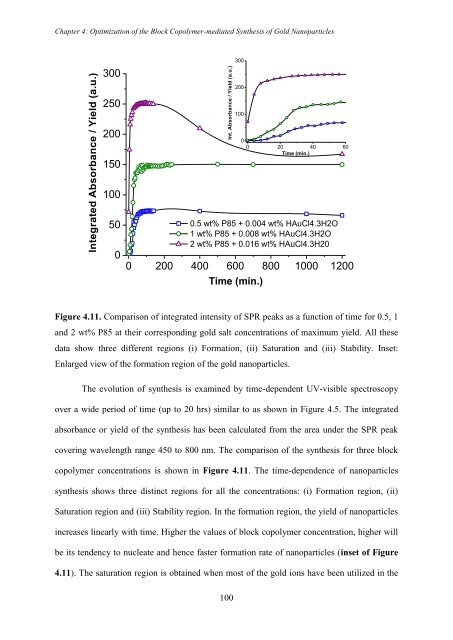PHYS01200704032 Debes Ray - Homi Bhabha National Institute
PHYS01200704032 Debes Ray - Homi Bhabha National Institute
PHYS01200704032 Debes Ray - Homi Bhabha National Institute
You also want an ePaper? Increase the reach of your titles
YUMPU automatically turns print PDFs into web optimized ePapers that Google loves.
Integrated Absorbance / Yield (a.u.)<br />
Int. Absorbance / Yield (a.u.)<br />
Chapter 4: Optimization of the Block Copolymer-mediated Synthesis of Gold Nanoparticles<br />
300<br />
250<br />
300<br />
200<br />
100<br />
200<br />
150<br />
0<br />
0 20 40 60<br />
Time (min.)<br />
100<br />
50<br />
0<br />
0.5 wt% P85 + 0.004 wt% HAuCl4.3H2O<br />
1 wt% P85 + 0.008 wt% HAuCl4.3H2O<br />
2 wt% P85 + 0.016 wt% HAuCl4.3H20<br />
0 200 400 600 800 1000 1200<br />
Time (min.)<br />
Figure 4.11. Comparison of integrated intensity of SPR peaks as a function of time for 0.5, 1<br />
and 2 wt% P85 at their corresponding gold salt concentrations of maximum yield. All these<br />
data show three different regions (i) Formation, (ii) Saturation and (iii) Stability. Inset:<br />
Enlarged view of the formation region of the gold nanoparticles.<br />
The evolution of synthesis is examined by time-dependent UV-visible spectroscopy<br />
over a wide period of time (up to 20 hrs) similar to as shown in Figure 4.5. The integrated<br />
absorbance or yield of the synthesis has been calculated from the area under the SPR peak<br />
covering wavelength range 450 to 800 nm. The comparison of the synthesis for three block<br />
copolymer concentrations is shown in Figure 4.11. The time-dependence of nanoparticles<br />
synthesis shows three distinct regions for all the concentrations: (i) Formation region, (ii)<br />
Saturation region and (iii) Stability region. In the formation region, the yield of nanoparticles<br />
increases linearly with time. Higher the values of block copolymer concentration, higher will<br />
be its tendency to nucleate and hence faster formation rate of nanoparticles (inset of Figure<br />
4.11). The saturation region is obtained when most of the gold ions have been utilized in the<br />
100

















